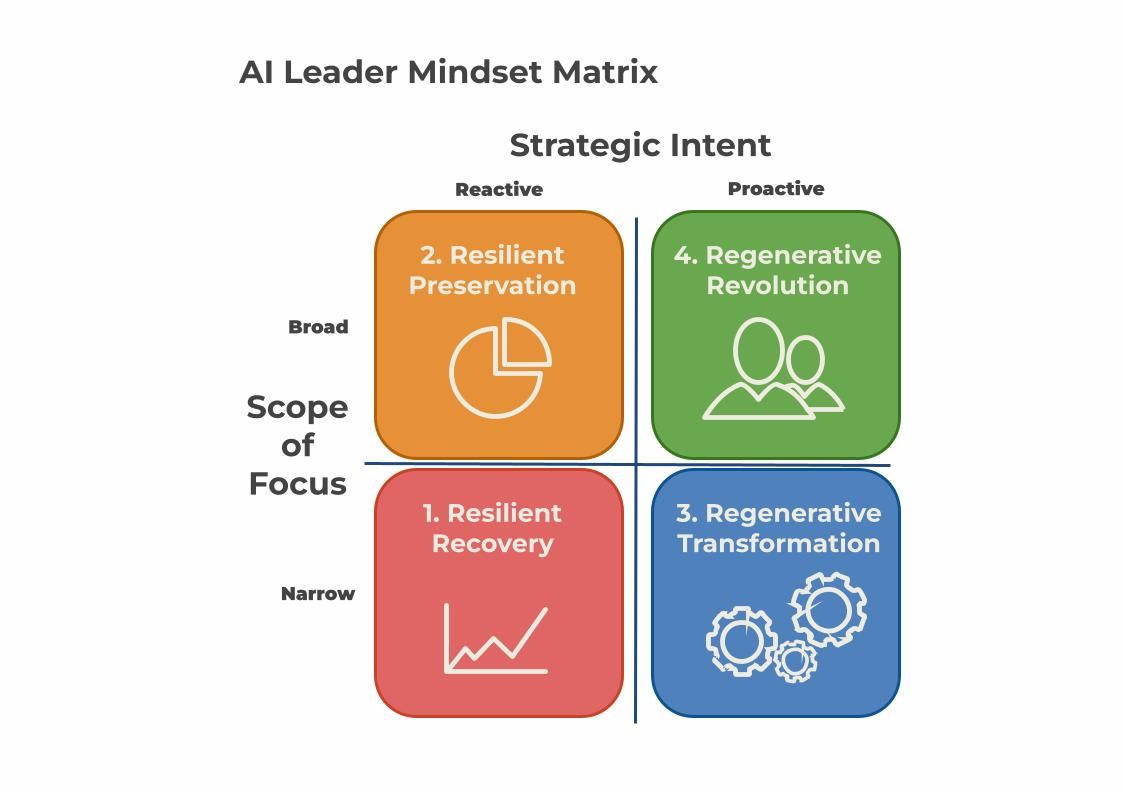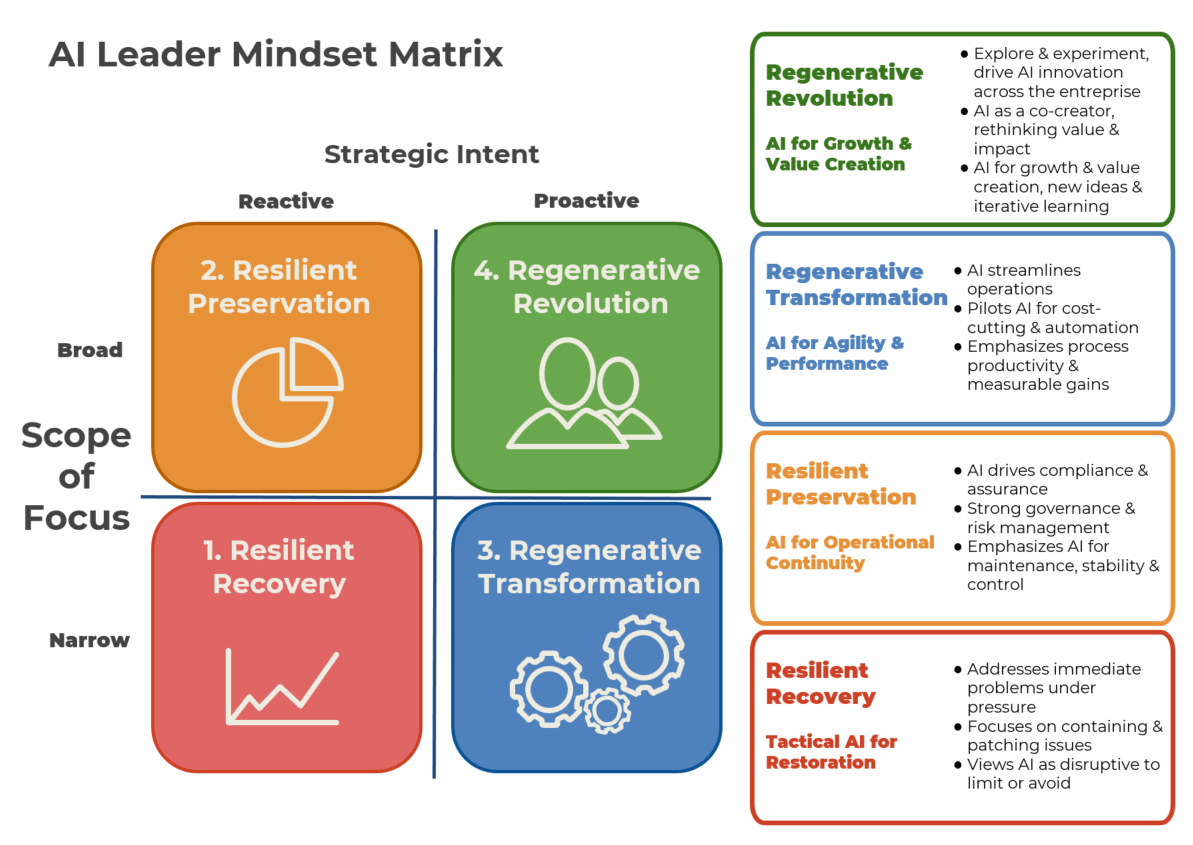
by Patrick Lynch, PhD.
I wasn’t expecting a leadership breakthrough on a trail in New Zealand, but it struck me. Trekking through the lush green fern forest, I kept seeing the spiraling koru, a Māori symbol of new life and evolution. Inspiring.
Later, a colleague put it into words for me, “It’s not enough to bounce back. We need to bounce forward.” That became our mantra. We named our initiative Project Koru, a reminder that change comes from growing, not returning.
With AI flooding boardrooms, I’m reminded of this lesson. The future belongs to leaders who spring forward like the koru, embracing change not to survive but thrive.
Some call this resilience, but what they mean is regeneration. Often conflated, one avoids scarcity, the other attracts abundance. Resilience restores function, valuable but reactive. Regeneration is expansive, creatively building new things.
I see this confusion in how leaders talk about digital transformation. It’s often just cleanup, paper reports become dashboards, and processes get automated. That’s resilience. Regenerative transformation asks, “What new value can AI create? How can AI do novel things, not just old things faster?” Resilience drives us to recover. Regeneration dares us to reimagine.
To help leaders like you know where you stand and where you need to go, I designed a new mindset matrix.
For years, resilience rallied leaders through disruptions from pandemics to politics. It’s vital, helping us bounce back and retain continuity. Agile and adaptive, it’s the corporate equivalent of a rubber ball, ready for the next volley.
But as AI becomes ubiquitous, ask, “Is resilience enough?” Resilience steadies organizations but won’t evolve them. That takes regeneration.
Picture two boardrooms. Both adopted the same AI tools with radically different visions. In the first, executives huddle over spreadsheets, calculating how many customer service reps they can cut with chatbots. Resilient leaders ask, “How do we maintain functions during disruption?”
In the second, leaders sketch new business models, imagining fresh products. Regenerative leaders ask, “How do we create value despite disruption?” They use this as fuel, becoming stronger, more effective than before.
This shift is happening but unevenly. Many leaders I meet think defensively about AI, “How do we protect our advantage?” instead of “How do we create new value?” They chase efficiency over creativity. Engineering resilience not designing regeneration.
I lived through the “save your way to prosperity” era when Six Sigma ruled transformation, squeezing juice from the same old berry. Cost-cutting protects today’s margins but rarely opens tomorrow’s markets. Efficiency has a ceiling. Innovation doesn’t. Choose wisely.
Wendy Collins, Chief AI Officer of NTT DATA recently shared, “The initial conversations around AI were all about improving operational efficiency and reducing costs by automating tasks. But that focus has proven to be too narrow. AI’s true value lies in helping organizations identify new revenue streams, optimize customer engagement and deliver better outcomes.”[1]
Wendy’s sentiment echoes global economist Joseph Briggs of Goldman Sachs’, who predicts that generative AI will boost U.S. GDP by 6.1% over the next decade, roughly $540 billion by 2028.[2] That growth stems from both new activity and automation, mirroring patterns we’ve seen in past tech innovation waves.
IBM‘s global executive survey finds 63% of leaders expect material financial impact from AI, while 85% anticipate new product breakthroughs. In one year, AI-driven innovation jumped from mid-level concern to top CEO priority.
As Jim Covello of Goldman Sachs put it, “What trillion-dollar problem is AI going to solve?”[3] Jim sees irrational exuberance in AI infrastructure spending to just automate tasks that were already cheap. That’s cost shifting, not regeneration.
Unlike past tech revolutions offering cheaper solutions, AI is an expensive technology still searching for its killer app. To justify investment, it must create new businesses. New products. New value.
That’s where you come in, a regenerative leader, creating what AI alone cannot.

It’s not your fault. Many AI strategies focus on tech readiness. But it’s not the tech that needs to be ready, it’s you. I recently told a group of MBAs, “I am the ‘I’ in AI,” because it’s much more about what we do with it than AI itself. We’re facing the biggest change management challenge in human history, yet people still focus on AI. Let’s shift from the artificial to the intelligence. That comes from you and me.
Leaders must prepare for a greater focus on the human side of transformation. The consultancy BCG advises a 10-20-70 model: 10% algorithms, 20% tech and data, and 70% people and processes.[4] AI alone won’t transform your business. The real impact comes when people adopt, adapt, and apply it.
So here we focus on your mindset. How you think about AI determines how far it will take you. AI will change your organization. Will you guide that change toward resilience or regeneration? The difference determines your relevance in the AI economy.
The path from resilience to regeneration isn’t intuitive. Most leaders know they need to evolve but lack a roadmap. Leadership in the AI age isn’t just about the tech you adopt, it’s how you think, where you focus, and who you’re building with. That’s why I designed the AI Leader Mindset Matrix.
The model builds on two leadership dimensions: Strategic Intent (Reactive to Proactive) and Scope of Focus (Narrow to Broad). The first asks, “Do you use AI to respond to disruption or shape what’s next?” The second: “Are your AI efforts limited to immediate operational needs or woven into a wider vision?”
These create four quadrants, from Resilient Recovery, where AI is managed in crisis mode, to Regenerative Revolution, where AI becomes a co-creator in reimagining value and purpose.
Think of this as a sensemaking tool asking: “Am I leading from fear or vision? From urgency or purpose? What would it mean to lead from regeneration instead of recovery?”
This is leadership adopting AI in crisis mode, not as a strategic partner but as a tool to patch problems and restore normalcy. The mindset is survivalist: keep the lights on, control damage, stabilize operations.
Charlie, a regional operations leader at an online retailer, panicked when a competitor slashed delivery times using AI. He scrambled to adopt a basic chatbot and automate routine logistics. Charlie’s motto: “Just survive the quarter.” With AI as digital triage, he solved symptoms, not systems.
This leader sees AI as a tool for continuity and compliance, safeguarding systems and ensuring predictable performance. The focus is defensive but broader, planning for long-term stability and risk mitigation. The goal is using AI to absorb shocks while functioning smoothly.
Angel, a financial services director, watched regulatory pressure mount around AI governance. Rather than resist, she led a comprehensive initiative implementing AI monitoring across all business units. After months of policy reviews, testing, and board-level sign-off, “Better safe than sorry” guides every decision.
This leader sees AI as a lever for improvement, streamlining processes, boosting efficiency, and enhancing existing capabilities. The mindset is competitive and efficiency oriented, but often limited to current business models.
Blake, a manufacturing manager, introduced AI-powered predictive maintenance and quality control. Productivity soared as employees shifted from reactive repairs to strategic supervision. Blake’s focus: “Making our people and processes better than they’ve ever been.”
Here, leaders treat AI as a collaborator to rethink purpose, value, and impact. AI becomes a co-creative partner, improving processes and redefining the organization’s role in serving people, planet, and profit.
Chris, chief innovation officer at a global consulting firm, rolled out an AI agent to coach staff. The system amplified client engagement, flagging biased proposals and diversifying recommendations. As teams interacted with the tool, collaboration deepened and knowledge shared more equitably. “AI should help us do more than scale,” Chris said. “It should help us heal.”

There’s a moment coming when you’ll have to choose your AI mindset. Most leaders don’t live in just one quadrant. We shift, sometimes by choice, often by crisis. You might lead with bold imagination for product development, defensive preservation for operations. But times are changing.
We urgently need regenerative leaders willing to aim AI at bold problems and build bolder solutions. Yes, AI is full of paradoxes[5]. It boosts productivity while displacing jobs. It accelerates medical breakthroughs and amplifies bias. It enhances security and enables threats. It democratizes knowledge and spreads misinformation.
Some leaders see these as trade-offs to manage: “How do I maximize benefits while minimizing harms?” Regenerative leaders see actionable challenges: “How do I use AI to build new solutions?”
Like the Māori koru, regenerative leaders adopt AI with ingenuity. They see it not as a shortcut but a catalyst to serve the whole while strengthening its parts. They know we must reimagine how we work, what we value, and who benefits. For our AI era, there’s nothing artificial about this intelligent choice: Are you a bounce back or bounce forward leader?

Patrick Lynch, PhD is AI Faculty Lead and Professor at Hult International Business School, specializing in AI-driven immersive experiences for global business. Former Accenture consultant and Wolters Kluwer Health executive, Patrick advises on emerging technologies to find, service and keep customers for startups and Fortune 500 companies. Passionate about shaping the future of work through marketing, analytics, and leadership.
[1] Global GenAI report NTT Data. (2025). Global GenAI report: How organizations are mastering their GenAI destiny in 2025. Retrieved from Global GenAI Report | NTT DATA https://partners.wsj.com/ntt/forging-paths-to-progress-the-innovation-spectrum/wp-content/uploads/sites/1406/2025/01/Future-Ready-Innovation-Strategies-for-2025-and-Beyond.pdf
[2] Goldman Sachs Global Macro Research. (2024, June 25). GEN AI: Too much spend, too little benefit? (Issue Brief No. 129). https://www.goldmansachs.com/insights/top-of-mind/gen-ai-too-much-spend-too-little-benefit
[3] Goldman Sachs Exchanges. (2024, July 16). A skeptical look at AI investment [Audio podcast episode]. Exchanges: Goldman Sachs. https://megaphone.link/GLD5324605171
[4] Apotheker, J., Duranton, S., Lukic, V., de Bellefonds, N., Iyer, S., Bouffault, O., & de Laubier, R. (2025, January 15). From potential to profit: Closing the AI impact gap. Boston Consulting Group. https://www.bcg.com/publications/2025/closing-the-ai-impact-gap
[5] World Economic Forum. (2024). The Global Risks Report 2024 (19th ed.). https://www.weforum.org/publications/global-risks-report-2024/

Thinkers50 Limited
The Studio
Highfield Lane
Wargrave RG10 8PZ
United Kingdom

Thinkers50 Limited
The Studio
Highfield Lane
Wargrave RG10 8PZ
United Kingdom

Thinkers50 Limited
The Studio
Highfield Lane
Wargrave RG10 8PZ
United Kingdom
| Cookie | Duration | Description |
|---|---|---|
| LANG | 9 hours | Linkedin set this cookie to set user's preferred language. |
| nsid | session | This cookie is set by the provider PayPal to enable the PayPal payment service in the website. |
| sp_landing | 1 day | The sp_landing is set by Spotify to implement audio content from Spotify on the website and also registers information on user interaction related to the audio content. |
| sp_t | 1 year | The sp_t cookie is set by Spotify to implement audio content from Spotify on the website and also registers information on user interaction related to the audio content. |
| tsrce | 3 days | PayPal sets this cookie to enable the PayPal payment service in the website. |
| x-pp-s | session | PayPal sets this cookie to process payments on the site. |
| __cf_bm | 30 minutes | This cookie, set by Cloudflare, is used to support Cloudflare Bot Management. |
| Cookie | Duration | Description |
|---|---|---|
| l7_az | 30 minutes | This cookie is necessary for the PayPal login-function on the website. |
| Cookie | Duration | Description |
|---|---|---|
| CONSENT | 2 years | YouTube sets this cookie via embedded youtube-videos and registers anonymous statistical data. |
| _ga | 2 years | The _ga cookie, installed by Google Analytics, calculates visitor, session and campaign data and also keeps track of site usage for the site's analytics report. The cookie stores information anonymously and assigns a randomly generated number to recognize unique visitors. |
| _gat_gtag_UA_10408481_1 | 1 minute | Set by Google to distinguish users. |
| _ga_ZP8HQ8RZXS | 2 years | This cookie is installed by Google Analytics. |
| _gid | 1 day | Installed by Google Analytics, _gid cookie stores information on how visitors use a website, while also creating an analytics report of the website's performance. Some of the data that are collected include the number of visitors, their source, and the pages they visit anonymously. |
| Cookie | Duration | Description |
|---|---|---|
| NID | 6 months | NID cookie, set by Google, is used for advertising purposes; to limit the number of times the user sees an ad, to mute unwanted ads, and to measure the effectiveness of ads. |
| test_cookie | 15 minutes | The test_cookie is set by doubleclick.net and is used to determine if the user's browser supports cookies. |
| VISITOR_INFO1_LIVE | 5 months 27 days | A cookie set by YouTube to measure bandwidth that determines whether the user gets the new or old player interface. |
| YSC | session | YSC cookie is set by Youtube and is used to track the views of embedded videos on Youtube pages. |
| yt-remote-connected-devices | never | YouTube sets this cookie to store the video preferences of the user using embedded YouTube video. |
| yt-remote-device-id | never | YouTube sets this cookie to store the video preferences of the user using embedded YouTube video. |
| yt.innertube::nextId | never | This cookie, set by YouTube, registers a unique ID to store data on what videos from YouTube the user has seen. |
| yt.innertube::requests | never | This cookie, set by YouTube, registers a unique ID to store data on what videos from YouTube the user has seen. |
| Cookie | Duration | Description |
|---|---|---|
| DEVICE_INFO | 5 months 27 days | No description |
| loglevel | never | No description available. |
| m | 2 years | No description available. |
Thinkers50 Limited has updated its Privacy Policy on 28 March 2024 with several amendments and additions to the previous version, to fully incorporate to the text information required by current applicable date protection regulation. Processing of the personal data of Thinkers50’s customers, potential customers and other stakeholders has not been changed essentially, but the texts have been clarified and amended to give more detailed information of the processing activities.